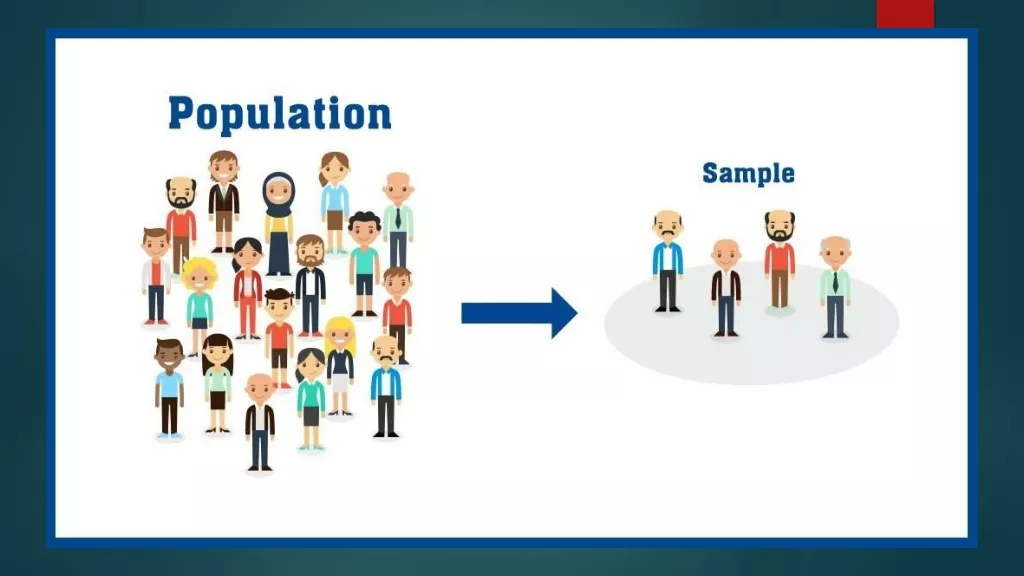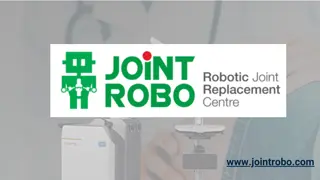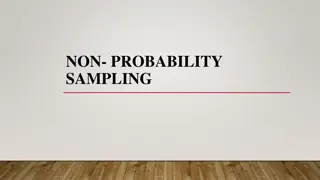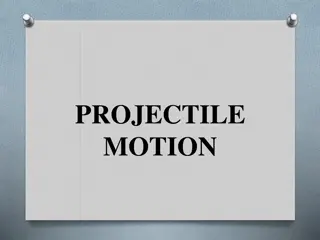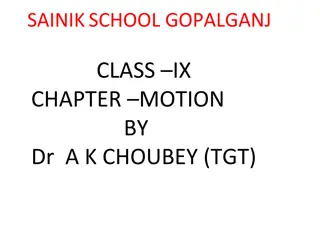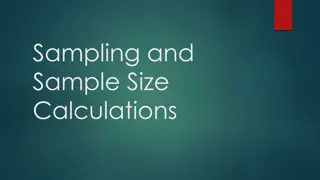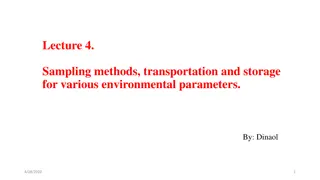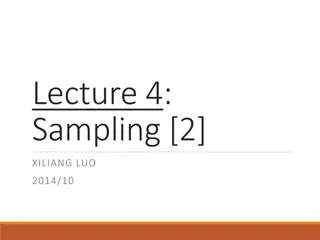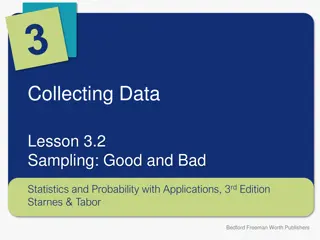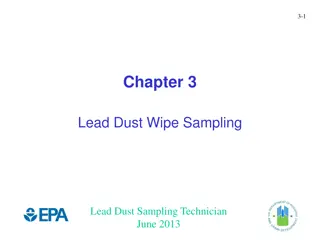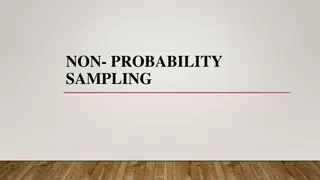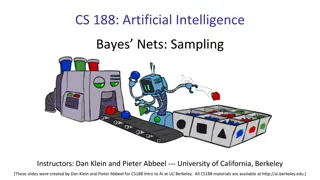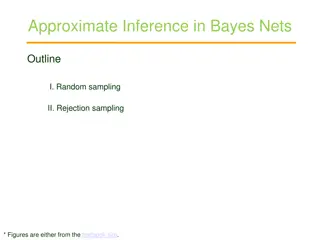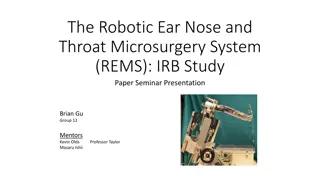Novel Learning and Sampling Motion Planner for Robotic System
This presentation discusses a novel learning and sampling-based motion planner for high-dimensional robotic systems. It covers the motion planning problem, proposed methods, role of team members, background on RRT and RRT*, as well as Deeply Informed Neural Sampling. The focus is on addressing challenges in managing high degrees of freedom in robotic systems, such as humanoid robots. Cutting-edge approaches like Learned Latent Rapidly-exploring Random Trees are also explored to improve speed and efficiency in motion planning.
Download Presentation

Please find below an Image/Link to download the presentation.
The content on the website is provided AS IS for your information and personal use only. It may not be sold, licensed, or shared on other websites without obtaining consent from the author.If you encounter any issues during the download, it is possible that the publisher has removed the file from their server.
You are allowed to download the files provided on this website for personal or commercial use, subject to the condition that they are used lawfully. All files are the property of their respective owners.
The content on the website is provided AS IS for your information and personal use only. It may not be sold, licensed, or shared on other websites without obtaining consent from the author.
E N D
Presentation Transcript
Final presentation: Novel Learning and Sampling-based Motion Planner for High-Dimensional Robotic System Minh-Tuan Tran - Andrea Finazzi - Shinjeong Kim 2020.12.8 1
Content I. Introduction II. Background and Relative work III. Problem of Current Technique IV. Proposed Method V. Role of Members 2
I. Introduction 1. Motion Planning Problem definition & applications 2. Motion Planning for High- dimensional Robotic System 3
1. Motion Planning Problem definition & Applications ????? Motion Planning Problem Given: Free State Space (?????) Obstacle State Space (????) Init state (?????) Goal state (?????) Objective: Finding the collision-free trajectory from ????? to ?????. ???? ????? collision-free trajectory Applications Robot, Autonomous driving, etc. ????? 4
2. Motion Planning for High-dimensional Robotic System Humanoid Robot OpenAI RoboSchool : 50 DOF Existing approaches did not succeed to manage high DOF A high performance, novel approach for high-dimensional C-space is necessary. 5
II. Background and Relative work 1. RRT and RRT* 2. Deeply Informed Neural Sampling (DeepSMP) 3. Motion Planning for High-dimensional robotic 4. Learned Latent Rapidly-exploring Random Trees (L2RRT) 6
1. RRT and RRT* a. Rapidly-exploring Random Tree (RRT) Repeatedly expand tree until reach goal Probabilistically complete ????? Not Optimal b. RRT* RRT + Connection refinement (Rewire) Probabilistically complete Asymptotically optimal Low speed for complicated C-space 7
2. Deeply Informed Neural Sampling (DeepSMP) Offline Online 1. ???? ???? (??,??,?) Encoder Encoder 2. (??, ??,?) DeepSampler ? = ?(????;??) DeepSampler Decoder ??+1 ????= ?(?;??) ??+1 Contractive AutoEncoder Deep Sampler Neural Sampling (DeepSMP) Speed was improved Still not suitable for high dimensional problem 8
3. Motion Planning for High-dimensional robotic Previous methods cannot handle high-dimension. Why? RRT family : designed for mobile robots and low DOF robotic arms not suitable for high-dimensional problem [1] DeepSMP family : heavily rely on training data e.g. DeepSMP : DeepSampler is trained by path from RRT*; also not suitable 9
4. Learned Latent Rapidly-exploring Random Trees (L2RRT) a. Latent Sampling-based Motion Planning (L-SBMP) This model is divided into three parts: Autoencoder Network Dynamics Network Collision Checker 10
4. Learned Latent Rapidly-exploring Random Trees (L2RRT) Differences compared to RRT All operations are done on latent space (e.g. sampling, tree extension) ????? Use dynamics network to extend tree Use collision check network to check if successive states are collision-free Main Idea Project all high-dimensional states to lower states and handle them ????? ?? ?? Then, high-dimensional problem can be handled (e.g. Humanoid robot) ??????? ????? ?? ?? 11
III. Problem of Current Technique What is the main weak point of L2RRT Both of those loss function just use for checking whether latent predicted state is correct with real predicted state They use the random ?? for dynamic network So that, this approach just lead the dynamic network to learn the path of the random sampling like RRT in full state problem. So, it leads to the poor performance of L2RRT. 12
III. Problem of Current Technique What is the main weak point of DeepSMP: DeepSMP don t suitable for high-dimensional motion planning due to the lack of training data. 13
IV. Proposed Method 1. Training L-SBMP 2. L2RRT* 3. Training DeepControlSampler 4. Predict Phase 14
IV. Proposed Method 1. Training L-SBMP The training data for the autoencoderand dynamics network consists of 10,000 environments, each with a trajectory of 10 successive states and control inputs. The training data for the collision checking network consists of 25,000 environments, again with 10 pairs of statesand a collision label. 15
IV. Proposed Method 2. L2RRT* We can add some more step in L2RRT to let it become L2RRT* which can provide the near-optimal path. ????? ????? Step 2: With each iterator: ???? Step 2.1: Sampling the ??????? 3 1 ?????? Step 2.2: Choice the node ??????? nearest to ??????? 1 5 2 Step 2.3: Random the ??and use it as input of the trained dynamic network to predict ???? Step 2.4: Use the trained checking collision network to check collision-free of ???? and ??????? 16
IV. Proposed Method 2. L2RRT* Step 2.5: check the radius near ????to find the neighbor. Assume that ????? is the neighbor. ????? ????? Step 2.6: computing the cost to move from ???? to ?????. ???? 3 1 ?? ????? = ???? ????,????? + ????????? ?????? ?? 1 5 2 Current Cost (ccost) Parent Node (pn) Full state node 4 ???? ?? ???? 11 ????? ????? ?? 17
IV. Proposed Method 2. L2RRT* Step 2.5: check the radius near ????to find the neighbor. Assume that ????? is the neighbor. ????? ????? Step 2.6: computing the cost to move from ???? to ?????. ???? 3 1 ?? ????? = ????(????,?????) + ????????? ?????? ?? 1 5 2 Step 2.7: if ????? < ?????????? then use trained checking collision network to check collision-free of ???? and ?????. Current Cost (ccost) Parent Node (pn) Full state node 4 ???? ?? ???? 11 ????? ????? ?? 18
IV. Proposed Method 2. L2RRT* Step 2.5: check the radius near ????to find the neighbor. Assume that ????? is the neighbor. ????? ????? Step 2.6: computing the cost to move from ???? to ?????. 2 ???? 1 ?? ????? = ????(????,?????) + ????????? ?????? ?? 1 5 2 Step 2.7: if ????? < ????? ?? ????? then use trained checking collision network to check collision-free of ???? and ?????. Current Cost (ccost) Parent Node (pn) Full state node 4 ???? ?? ???? 6 ????? ????? ???? If there are collision-free then ??????????= ?????and ??????? = ???? Based on L2RRT* we can generate the near-optimal path 19
IV. Proposed Method 3. Training DeepControlSampler ObsEncoder DeepControlSampler ???? encoder ???? ?? ???? ?? ????? decoder ???? With the training data will be generated from the near-optimal path of L2RRT* 20
IV. Proposed Method 4. Predict Phase: Use the trained deep control sampler to predict ?? 21
IV. Proposed Method 4. Predict Phase: Predict ??+? by the trained dynamic network with ?? and ?? as the input. 22
IV. Proposed Method 4. Predict Phase: Check the collision of ?? and ??+? with the trained checking collision network. 23
IV. Proposed Method 4. Predict Phase: With this model, We can utilize both of the efficiency of neural network-based predictor and the suitability for high-dimensional of L2RRT. 24
V. Experiments 1. Network Implementation 2. Training Process 3. Evaluation 4. Conclusions 25
1. Network Implementation Environment: TensorFlow v1 (cpu only) Ubuntu 20.04 on DELL XPS 15 Network Structure: Input (516): z_t, z_goal, z_Obs Obstacle space preprocessor, from the CC network (pre-trained): 5 dense layers with 50% dropout Control network: 5 dense layers with 50% dropout Output (2): u_t 26
2. Training Process: Training Data We used L2RRT to generate trajectories for our model training. 100 problems: 70 for training, 20 for testing, 10 for evaluation Training: ~500 rows Testing: ~100 rows Each best trajectory of training and test data is represented as a sequence of control inputs. u_t z_goal For each best trajectory we gather multiple segments (rows): {z_t, z_goal, z_obs, u_t} Z_t Z_0 27
2. Training Process We compare the predicted control and the target by a Mean Squared Error loss function: ? ? =? ? ?? ? ?=? ?? The Adam Optimizer available in tensorflow is used to minimize the loss, with: Learning rate: 0.0001 28
3. Evaluation Planning problem in a 32x32 pixels environment 29
3. Evaluation 10 Evaluation Problems are solved with max 5000 samples. 5 Different Scenarios: 1. Random control (L2RRT) 2. 25% learned control 3. 50% learned control 4. 75% learned control 5. 100% learned control 2 Evaluation Rates: 1. Success Rate: number of solved problem at each iteration 2. Cost Rate: normalized cost of the best solution at each iteration 30
3. Evaluation: Success Rate Solved problems Samples 31
3. Evaluation: Cost Rate Cost (normalized) samples 32
3. Evaluation: Latent Space Visualization Random *Third problem of the evaluation set. 1000 samples limit 50% Learned 33
4. Conclusions First results are promising We faced some limitations implementing and evaluating the algorithm: Training data at our disposal was limited. The complexity of the visual problem is limited. L2RRT* cannot be implemented without inverse kinematics, so optimal controls cannot be generated. 34
4. Conclusions Besides, we could further improve our model by: Improving the network design process. Generate new problems or augment the environment complexity (e.g. humanoid robot) Evaluate the effectiveness of collision checking in control generation, defining a collision rate parameter. 35
VI. Role of Members Member Role Shinjeong Kim Write the Introduction and Relative work sections Discuss about proposed method Discuss about implementation approach and results Andrea Finazzi Write the Experiment section Discuss about proposed method Implement and evaluate the experiments Minh-Tuan Tran Write the Proposed Method section Discuss about proposed method Discuss about implementation approach and results 36
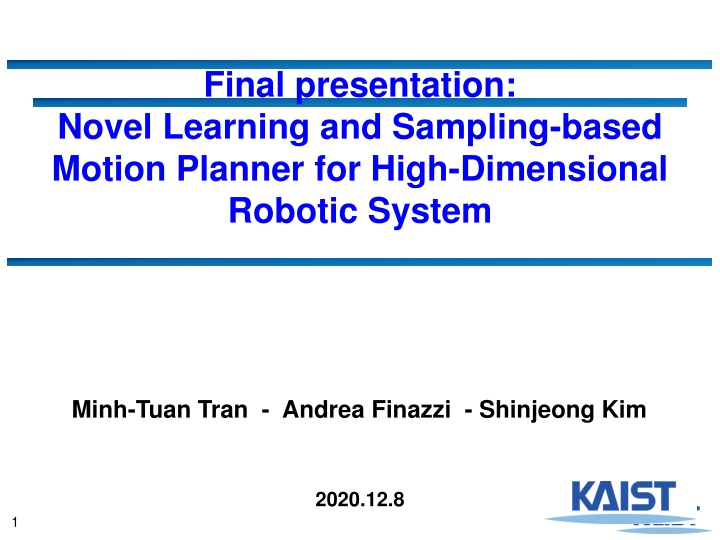

![❤[READ]❤ Robotic Exploration of the Solar System: Part I: The Golden Age 1957-19](/thumb/21623/read-robotic-exploration-of-the-solar-system-part-i-the-golden-age-1957-19.jpg)
